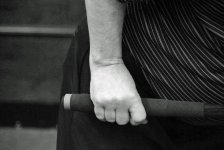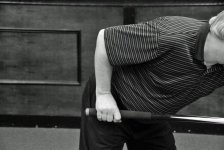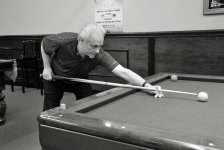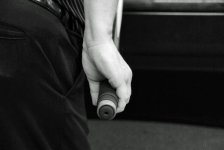This is an excerpt from my Book/dvd, "The Concise Book of Position Play," in the Fundamentals chapter.
I hope this info for help anyone that is interested.
The Grip
The proper full hand grip
The grip gives the player general control of the cue ball. Full finger grips are the most common choice among better players. The grip should rest in the palm of your hand; see Photo10, instead of lying in the player's fingers.
View attachment 490350
Photo 10
The players that use more of their wrists give more rotation to the cue as it is swung back and forth. You may want to use a finger grip when applying maximum effect to the cue ball, (the cue ball maintains spin on 3 or more cushions.) For most shots in 3 cushion billiards, (especially short-angle shots), you want to use as little wrist action as possible, for better control of the cue ball, and a consistent hit on the first ball or cushion.
The proper position of the elbow and arm at address
The proper position of the upper arm and elbow (lower arm) are the key to your stroke. All strokes are slightly different due to our different physiology, but we share the same basic fundamentals. A player's lower arm should be perpendicular to the floor and upper arm parallel to the floor, Photo 11. While stroking the cue, you will experience the wrist breaking prior to contacting the cue ball. This will bring rhythm, timing and consistency to your game.
View attachment 490351
Photo 11
View attachment 490352
Photo 12
Just at the point before contacting the cue ball, the player will have better rhythm and timing in their delivery of their cue. It's at that split second when the wrist breaks, just before contacting the cue ball, Photo12. This is the main reason why some players are able to create more effect on the cue ball than other players; fortunately, I've been one of those players that possesses this attribute.
The simple move
The last element of a proper grip is the simplest. Most average players are looking for some magical move to make just before they strike the cue ball, well; I'm here to tell you, there isn't one. It's the simple opening of the hand on the cue when swinging the cue back, Photo13, and when the cue swings forward closing the hand around the cue with all fingers, Photo14. Also the middle knuckles on the cue hand, should be pointing to the floor. This along with the arm and the elbow in the correct position when addressing the cue ball will give the player a more consistent effect on the cue ball.
View attachment 490356
Photo 13
View attachment 490355
Photo 14




